Contents
- Current (through June 13) degree day (DD) Accumulations
- Orchard Radar insect synopsis
- Orchard radar preliminary McIntosh harvest date forecast
- Upcoming meetings
- The way I see it
- Enhancing return bloom of apple
- A break in the action
- Useful links
Current (through June 13) degree day (DD) Accumulations
Location: UMass Cold Spring Orchard (CSO), Belchertown, MA
Base 43: 1043
Base 50: 625
Significant upcoming orchard insect events based on degree days (Base 43):
Obliquebanded leafroller 1st flight peak: 843-1139
Peachtree borer 1st flight catch: 789-1353
Orchard Radar insect synopsis
Note: with each issue of Healthy Fruit we will be reprinting selected apple insect degree-day model highlights from Glen Koehler's (U. of Maine) Orchard Radar output for Belchertown, MA. You can access the full Orchard Radar output here: http://pronewengland.org/AllModels/DecisionModels.htm
- Codling moth (CM), 1st generation, first sustained trap catch biofix date: May 17, Tuesday. 1st generation adult emergence at 80% and 1st generation egg hatch at 30%. 1st generation 20% CM hatch = June 9, Thursday = target day where one spray needed to control 1st generation CM.
- 1st generation obliquebanded leafroller (OBLR) flight begins around: June 5, Sunday. Early egg hatch and optimum date for initial application of B.t., Delegate, Proclaim, Intrepid, Rimon, Altacor, Belt, pyrethroid or other insecticide effective against OBLR (with follow-up applications as needed) : June 21, Tuesday.
- Spotted Tentiform Leafminer (STLM): 2nd STLM flight begins around: June 12, Sunday. Rough guess of when 2nd generation sap-feeding mines begin showing: July 2, Saturday. Optimum sample date for 2nd generation STLM sapfeeding mines is July 10, Sunday.
Orchard Radar preliminary McIntosh harvest date forecaat
Harvest date estimates are based on temperature observations from the first 30 days after Full bloom. See http://pronewengland.org/AllModels/MAmodel/MA-Belchertown-HarvestDates.htm for full explanation.
- Date to apply ReTain to delay first harvest for apples which without treatment would be ready for storage harvest on September 5 is Monday, August 8. Begin measuring actual McIntosh starch-iodine index no later than Wednesday, August 24.
- The Michigan formula estimates that non-spur McIntosh will reach starch index 4.0 and start the optimum harvest window for long term storage on Monday, September 5.
- Using the Hudson Valley NY formula, McIntosh maturity is forecast to reach starch index 6.0 in
Belchertown MA on Wednesday, September 21.
Upcoming meetings
June 14, 15, 16, 2011: Tree fruit twilight meetings.
Tuesday, June 14, Kosinski Farms, 420 Russellville Rd., Westfield, MA
Wednesday, June 15, Red Apple Farm, 455 Highland Ave., Phillipston, MA
Thursday, June 16, Highland Farm, 635 Highland St., Holliston, MA
- Tree fruit twilight meetings start promptly at 5:30 PM.
- Pesticide recertification credit(s) will be offered.
- There will be a $25 meeting admission charged at the door. ($20 for Massachusetts and Rhode Island Fruit Growers' Association FULL members.)
- A light meal or snack is typically served at all meetings.
- For more information, call Jon Clements: 413-478-7219.
June 15, 2011: Commonwealth Quality Produce Kick-off Event, 9:45 AM to 12 PM. Verrill Farm, 11 Wheeler Rd., Concord, MA. Light refreshments will be served. RSVP Michael Botelho, 617-626-1721, botelho@state.ma.us
July 18, 2011: Massachusetts Fruit Growers' Association Summer Meeting, Parlee Farms, Tyngsoboro, MA
The way I see it
The apple-crop is shaking out to be somewhat variable, June drop being heavy on some varieties and not so heavy on others. Random clusters of fruit here and there are common, but overall between natural and chemical thinners a lot of fruit has come off. Overall, the apple and peach crops look at least good, however, the sweet cherry crop is going to be off because of significant atrophy of fruitlets:
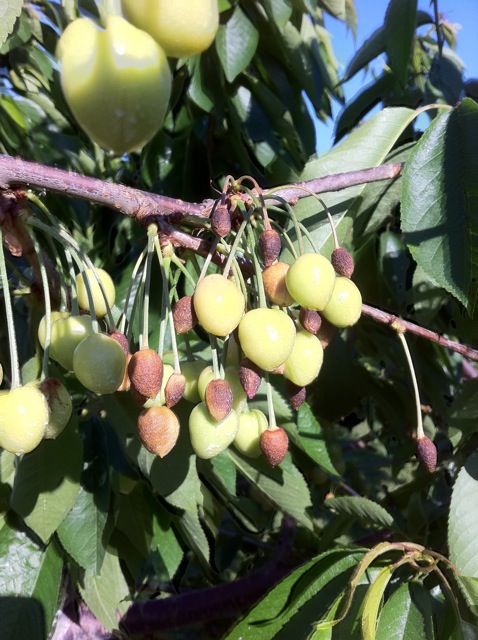
I have seen some significant strep injury to young trees where it was applied for fire blight. Chalk it up to the tender foliage I guess. See picture:
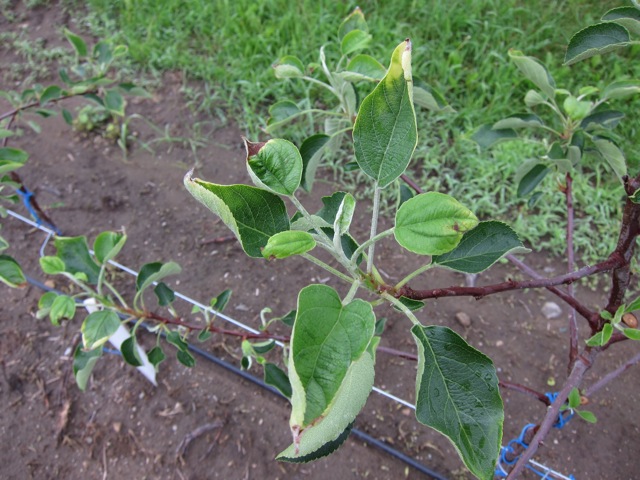
Within the past week a significant pheromone trap capture of obliquedbanded leafroller (OBLR) adults has appeared at the UMass Orchard. This sets the biofix for timing treatment of the larvae if necessary. I found the NEWA assessment of OBLR for Belchertown to be right on:
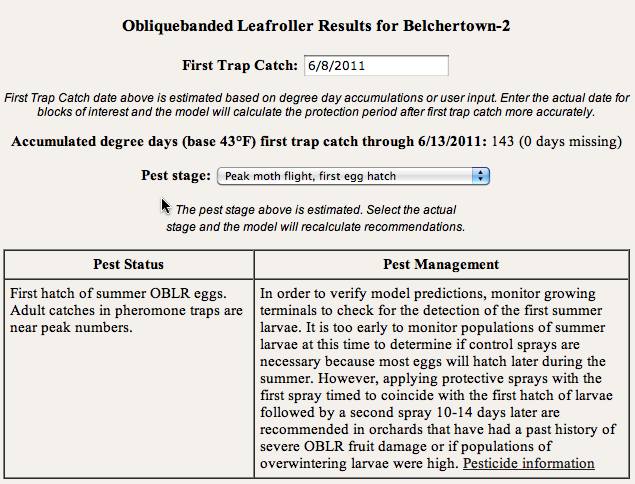
Enhancing return bloom of apple
Win Cowgill, Rutgers Cooperative Extension, and Wes Autio, UMass Amherst
Reprinted from UMass Fact Sheet 'Enhancing Return Bloom of Apple' F-131R -- 2009
Apple flower buds are formed in June and July for most varieties. Roughly 25-30 days after full bloom is the rule of thumb for the end of the thinning window, and the beginning of the flower bud development stage. Though this is a rough guideline, actual physiological responses are a result of degree day accumulations.
In addition to utilizing the hormonal type chemical thinners (NAA, NAD, 6-Ba, ethephon) at the normal thinning windows, research has shown that both NAA and Ethephon can be also be applied in supplemental applications to enhance flower bud formation for the following season.
Beginning when king fruit are 30-35mm in diameter (roughly 4-6 weeks after bloom, depending on temperature), growers can begin using ethephon or NAA applications to stimulate return bloom.
Ethephon
Ethephon is a synthetic compound that is broken down in plant tissue to form ethylene. When applied during flower bud development on apples (June-Early Jul), Ethephon can be highly effective in influencing return bloom. We suggest using Ethephon at 150 ppm which is 0.5pints/100 gallons. Further, ethephon treatments should begin when fruit are 30-35 mm (1.2-1.4 inches) in diameter. See Table 1 for the number of weekly appliations recommended per variety.
Table 1. Varietal recommendations for ethephon applications to enhance return bloom
| Variety | No. of weekly 150 ppm ethephon applications starting at 30-35 mm |
| Paulared | 1 |
| Gingergold | 1-2 |
| Honeycrisp | 4 |
| Gala | 2 |
| Macoun | 2 |
| Empire | 2-3 |
| Jonagold | 2-3 |
| Golden Delicious | 2-3 |
| Mutsu | 2-3 |
| Fuji | 4 |
| Suncrisp | 4 |
| Goldrush | 4 |
Ethephon on non-bearing apples can be used at 300-450 ppm (1-1.5 pts/100 gallons) beginning 2-4 weeks after full bloom. However, these trees should have filled their space and be ready to bear the following year. Ethephon will reduce tree growth.
NAA
NAA can also be used for return bloom. One approach to is to use NAA when fruit reach 30-35mm in diameter (about 4- 6 weeks after bloom, depending on temperature, see picture) at 5 ppm and make repeat applications at 5 ppm at 7-day intervals. The label calls for up to 3 applications on hard-to-thin cultivars. West Coast growers have experimented with up to 5 applications. Some observations have suggest that Fruitone-L has greater activity than Fruitone-N.
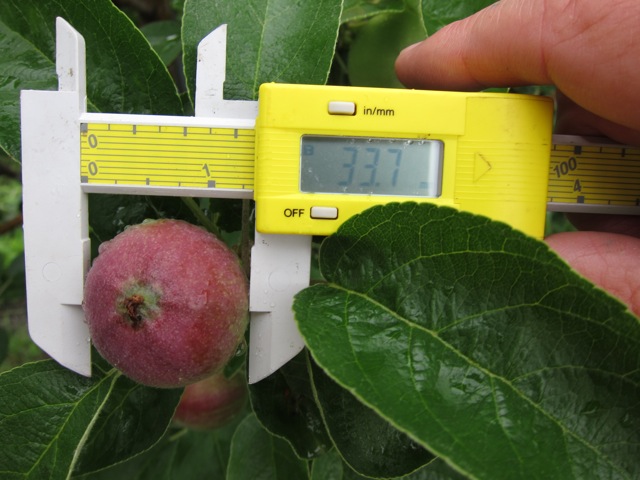
Cautions
- Ethephon applications at high temperatures and high rates can defruit trees, make sure you are past June drop and observe the temperature for the day of application + 2 days.
- NAA can reduce fruit size; this may be a concern on small- fruited cultivars.
Conclusion
Growers considering the use of PGR’s for return bloom need to be in tune with their orchard conditions before making any application. PGR’s can be very beneficial to a growers operation by breaking a biennial cycle, but their use requires a careful understanding of all parameters their application can influence. Begin slowly and follow all label rates, guidelines and precautions. The label is the law.
Note: The above information was developed from research and observations in New Jersey, other portions of the Mid Atlantic and Massachusetts fruit growing regions.
A break in the action
Dan Cooley, UMass Amherst
Primary apple scab season has ended in virtually all parts of Massachusetts, so it’s time to switch fungicide timing to target sooty blotch and flyspeck. This is a time when growers can take a break from fungicide sprays, but should consider the following guidelines when deciding when to start SBFS sprays.
First, make sure scab is under control before taking any break from fungicide applications. Active scab has to be controlled now to prevent fruit infections. If there is active scab in a block, regular fungicides to both suppress the scab and protect developing fruit still need to be applied.
If scab has been successfully controlled, then the most important disease problem for the rest of the season is generally SBFS. SBFS doesn’t present a serious risk until it has a chance to develop spores on reservoir plants near an orchard. Those spores are blown into orchards, land on fruit and grow slowly. Without fungicides, sooner or later they will develop into the specks and smudges that are the signs of SBFS.
SBFS spores develop around the time of apple bloom, but apples are protected by scab fungicides. However, when scab fungicides are stopped, the spores can start to grow on apples. It takes some time for SBFS fungi to establish and produce visible signs on fruit. The best estimate is that fruit have to be wet for 180 hrs. for SBFS to grow from a new infection to visible signs. Up to that point, fungicides can be used to eliminate SBFS fungi or at least stop their development.
So, to time SBFS fungicide applications, the first thing that is needed is a starting point, called a biofix. To get a biofix, the date the last scab fungicide application was made is needed. This spray will protect fruit from SBFS for some time. That time can be simply estimated to be about 2 weeks. However, a more precise estimate can be made based on which fungicide was used, how much rain has fallen and how long it has been from the application. Basically, fungicide protection breaks down over time because fungicides are exposed to sun and oxidation, washed from a plant’s surface, or fail don’t cover new growth. The days from the last fungicide application and the amount of rainfall that has fallen since the last application can be used to determine whether the fungicide is still protecting against SBFS. Dave Rosenberger at Cornell has developed estimates for duration of fungicide protection against SBFS. Fungicides fall into one of three groups, according to the following table.
So, to figure out when the biofix is, note what fungicide was used in the last scab application, see whether it’s in Group A, Group B or Group C. Then apply the appropriate Depletion Rule. In a dry year, the number of days will be most likely to determine depletion. In a wet year, inches of rain will be most likely to deplete fungicides. Whichever limit, rainfall or days elapsed, comes first will be the biofix.
Once the biofix is known, SBFS growth on fruit will be driven by wetness, often called leaf wetness. Leaf wetness hours, or LWH, are tracked and added from the biofix until it gets near the 175 hr. threshold. Then, it’s time to apply the first SBFS fungicide.
After the first fungicide, track fungicide depletion using the same rules that were used to determine the biofix. Reapply fungicides to maintain protection through harvest.
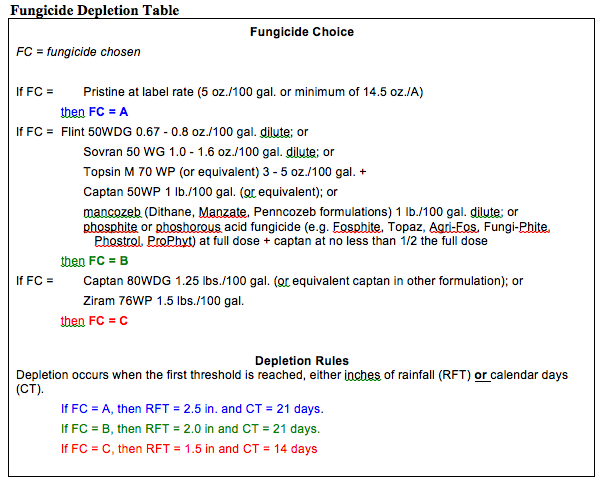
Useful links
UMass Fruit Advisor http://www.umass.edu/fruitadvisor/
Scaffolds Fruit Journal http://www.nysaes.cornell.edu/ent/scafolds/
Network for Environment and Weather Applications (NEWA)
JMCEXTMAN Blog http://jmcextman.blogspot.com/
Follow me on Twitter http://twitter.com/jmcextman and Facebook http://www.facebook.com/jmcextman
